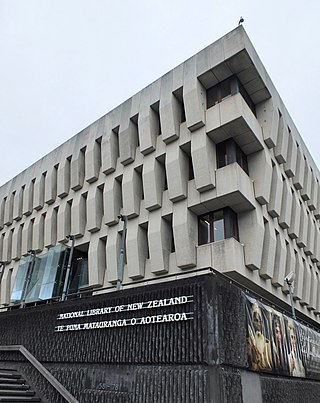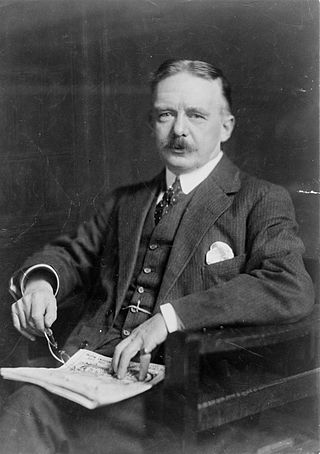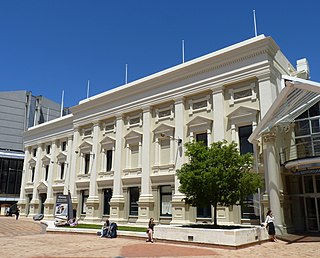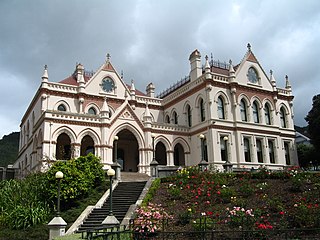
The National Library of New Zealand is New Zealand's legal deposit library charged with the obligation to "enrich the cultural and economic life of New Zealand and its interchanges with other nations". Under the Act, the library's duties include collection, preserving and protecting the collections of the National Library, significant history documents, and collaborating with other libraries in New Zealand and abroad.

The Beehive is the common name for the Executive Wing of New Zealand Parliament Buildings, located at the corner of Molesworth Street and Lambton Quay, Wellington. It is so-called because its shape is reminiscent of that of a traditional woven form of beehive known as a "skep". It is registered as a Category I heritage building by Heritage New Zealand.

New Zealand Parliament Buildings house the New Zealand Parliament and are on a 45,000 square metre site at the northern end of Lambton Quay, Wellington. They consist of the Edwardian neoclassical-style Parliament House (1922); the Parliamentary Library (1899); the executive wing, called "The Beehive" (1977); and Bowen House, in use since 1991. Whilst most of the individual buildings are outstanding for different reasons, the overall setting that has been achieved "has little aesthetic or architectural coherence".

Heritage New Zealand Pouhere Taonga is a Crown entity with a membership of around 20,000 people that advocates for the protection of ancestral sites and heritage buildings in New Zealand. It was set up through the Historic Places Act 1954 with a mission to "...promote the identification, protection, preservation and conservation of the historical and cultural heritage of New Zealand" and is an autonomous Crown entity. Its current enabling legislation is the Heritage New Zealand Pouhere Taonga Act 2014.
James Albert Beard was a New Zealand architect, town planner, and landscape architect.

Charles Wilson was a New Zealand politician of the Liberal Party. He was the first chief librarian of the General Assembly Library.

St Mary of the Angels is a Catholic church on the corner of Boulcott Street and O'Reily Avenue in Wellington, New Zealand. It is the parish church for Wellington Central and one of the major churches of the city. The Marist Fathers have provided clergy for St Mary of the Angels since 1874 in succession to its founding and long-serving parish priest, the Capuchin Franciscan, Father Jeremiah O'Reily. The church was used by Archbishop O'Shea as his pro-cathedral (1936–1954). It was the site of the funeral of Suzanne Aubert in 1926 and is well known for its church music tradition.

The Wellington Town Hall is a concert hall and part of the municipal complex in Wellington, New Zealand, which opened in December 1904. It is closed to the public since the 2013 Seddon earthquake for extensive strengthening work, and projected to reopen in January 2025.

The Hunter Building is the original building of Victoria University of Wellington's Kelburn campus in Wellington, New Zealand. It is a major landmark in the Wellington region and closely associated and considered a symbol of the university. The distinct architecture of the building is a notable example of Edwardian Gothic-revival, with red brick and Oamaru stone façade, along with grand internal entrances, staircases and original university library. The building is a noteworthy example of work from the Wellington architectural practice of Penty & Blake. While opened on the 30th of March 1906, the building was not completed to its original design, but was progressively added to as the college grew. The building is named after Sir Thomas Alexander Hunter, a well regarded professor of mental science and political economy. Following the end of the Great War, northern and southern wings were added to the building, providing new teaching areas, recreational spaces and a new library.

Gummer and Ford was an architectural firm founded in 1923 in Auckland, New Zealand, by William Gummer and Charles Reginald Ford. It was among the country's best-regarded architectural firm of the first half of the 20th century, designing numerous iconic buildings, including the former National Art Gallery and Dominion Museum in Wellington and the old Auckland Railway Station. Eighteen of the company's buildings have been registered as significant historic places by Heritage New Zealand. In 2006 an exhibition of their work was staged at The University of Auckland's Gus Fisher Gallery, and in 2007 the firm was described as 'the best architectural practice of all time in New Zealand'.

The New Zealand Parliamentary Library, known until 1985 as the General Assembly Library, is the library and information resource of the New Zealand Parliament. The present building that houses the library was completed in 1899; it survived a fire that destroyed the rest of the General Assembly building in 1907.

Cecil Walter Wood was a New Zealand architect. He was the dominant architect in Canterbury during the interwar period.

Thomas Turnbull (1824–1907) was a notable New Zealand architect.

Parliament House, in Lambton Quay, Wellington, is the main building of the New Zealand Parliament Buildings. It contains the Parliament's debating chamber, speaker's office, visitors' centre, and committee rooms. It was built between 1914 and 1922, replacing an earlier building that burned down in 1907. Parliament started using the yet to be completed building from 1918. Parliament House was extensively earthquake strengthened and refurbished between 1991 and 1995. It is open for visitors almost every day of the year, and is one of Wellington's major visitor attractions. Parliament House is a Category I heritage building registered by Heritage New Zealand.

The Wellington Central Library is a public library building in the central business district of Wellington, in New Zealand. It is owned by Wellington City Council and is listed as a Category 1 historic place by Heritage New Zealand. The building was opened in 1991 and was a key element of Wellington’s municipal centre, Te Ngākau Civic Square. It served as the main hub for the municipal library service, Wellington City Libraries.

The Public Trust Office Building is an office building in central Wellington, New Zealand, completed in 1908. It is the only (surviving) building "made of a true New Zealand granite – from Tonga Bay in north-west Nelson." It is also believed to be New Zealand's first steel-framed office building.

William Turnbull was an architect based in Wellington, New Zealand. He was the fourth and youngest son of architect Thomas Turnbull. He joined his father's practice in 1882 and became a partner in 1891. He was born in San Francisco where his father was working at the time. He moved to New Zealand with his family in 1871. In his younger years, he played rugby union at Poneke Football Club in Kilbirnie.
Susan Diana Price is a New Zealand writer, historian, researcher, philanthropist and expert on and collector of children’s books. She lives in Wellington.

Hokitika Museum is a museum in Hokitika on the West Coast of the South Island in New Zealand, and is the West Coast's largest museum and archive. It is housed in the historic Hokitika Carnegie Library building. Exhibitions include information about the gold rush and the unique West Coast stone pounamu (greenstone) and its value to Māori. The museum also holds a significant photographic collection. Seismic strengthening requirements closed the museum in September 2019. According to the Westland District Council Web site as of December 2021 the museum had not yet reopened.

Fergus George Frederick Sheppard was a New Zealand architect, who served as the chief government architect from 1959 until his retirement in 1971. During his time in this capacity he was involved with the design of the Beehive, among hundreds of other public buildings.



















